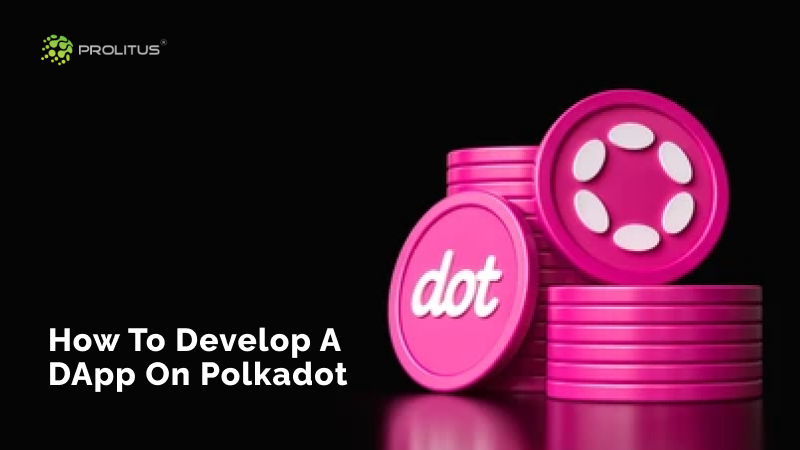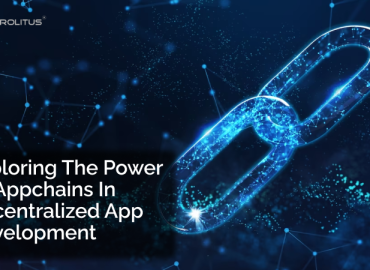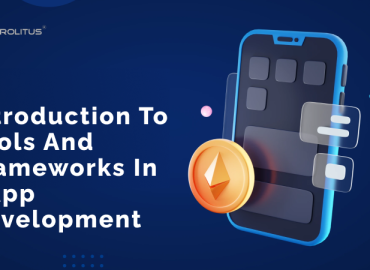Over the past decade, decentralized applications, or dApps, have become a high phenomenon in the “technological” industry. As a result, DApps, especially those on the Polkadot ecosystem, have become one of the most sought-after utilities among cryptocurrency enthusiasts. All thanks to their proven efficiency, absolute transparency, and top-notch security. This is evident by the fact that the daily number of dApp users has soared up 396% year-over-year to a monumental 2.4 million!
If you plan to launch your own Polkadot dApp, this article is the perfect place to kick off your journey into the crypto world. First, we would guide you through the brass tacks of dApps, their benefits, their need on Polkadot, and steps to launch dApps, among other relevant things.
What is a dApp?
In the simplest sense, dApps (abbreviated form of decentralized applications) are open-source software applications that primarily function on a peer-to-peer (P2P) blockchain network. They are used for creating a wide array of applications, from web browsing and social media apps to those for gaming and even decentralized finance.
A Polkadot dApp is quite similar looking to other website or mobile device-based applications, the only difference being that the former is P2P supported. In contrast, the latter runs on a single computer. Apart from existing under the control of a singular authority, given its decentralized nature, the codebase of dApps can be built upon by others even after its release.
As the decentralized network of dApps is supported by a high-end blockchain digital ledger, their use for data processing and transactional executions has become very prevalent among users.
Benefits of dApps
By now, you must have been well accustomed to the functioning and features of dApps; now, let’s dive deep into the plethora of benefits that they offer:
1) One of the most significant benefits of dApps is their ability to safeguard users’ privacy. DApp users are not required to submit their personal information for using the facilities provided by these dApps.
2) DApps maintain data integrity as the data stored on the dApps’ blockchain is unalterable. This is because consensus algorithms make blockchain data resistant to change.
3) DApp users do not have to face the central authority’s scrutiny, red-tapism, and permissions as they use smart contracts for inter-party transactions.
4) A hacker is least likely to target a dApp since there is no centralized network for attacking enough nodal networks.
5) It is natural for a decentralized application to be insusceptible to state-imposed censorship. No participant can delete or block messages posted on the blockchain network.
How To Launch a Project On Polkadot Using Dapp?
To launch a dApp project on the Polkadot ecosystem, you will have to use “Substrate, ” a blockchain framework for developing customized blockchains. Providing all the components necessary for building dApp projects on Polkadot, one can run the substrate with absolute autonomy.
- You must have the following two significant pre-requisites before planning to launch your Polkadot dApp:
- You should have elementary knowledge of manual and software-based programming.
- You should configure the locally-installed Rust so that a development environment is created on your computer system.
Step 1: Establishing a blockchain app using substrate
The substrate consists of several pre-formatted templates for setting up a development environment on your computer system. In addition, pre-formatted templates on the substrate can be used to set up a development environment.
You can refer to the following Substrate templates for adding more exciting features and customizations:
https://github.com/substrate-developer-hub/substrate-node-template
After this, you have to run the following commands for the integration of Nightly with Rust:
rustup update nightly
rustup target add wasm32-unknown-unknown –toolchain nightly
Then, you need to change the folder’s directory titled “./substrate-node-template.” Consequently, you have got to execute the latest version existing in the repository by running the following commands:
d substrate-node-template
git checkout latest
Now, you need to run the following command for compiling and running the previously installed node template within your Polkadot dApp project:
$ cargo build — release 2021–12–16 00:36:30 Running in — dev mode, RPC CORS has been disabled. 2021–12–16 00:36:30 Substrate Node … 2021–12–16 00:36:33 Highest known block at #0 2021–12–16 00:36:33 Prometheus exporter started at 127.0.0.1:9615 2021–12–16 00:36:33 Listening for new connections on 127.0.0.1:9944. 2021–12–16 00:36:36 Starting consensus session on top of parent 0x4bbcc70ccccc322d314a5df12a814c28d40e6879b7b930df5ac5a50fe4be4c30 2021–12–16 00:36:36 Prepared block for proposing at 1 (1 ms) [hash: 0x18f1c7bf91a1544c9a0e35ac08c8f036b4cb2f8d8297233fffadb94022b982a7; parent_hash: 0x4bbc…4c30; extrinsics (1): [0x6458…325e]] 2021–12–16 00:36:36 Pre-sealed block for proposal at 1. Hash now 0xf10d170d82617ff5df6752dc911d3483badf34b005c8c48a46aeb6b708c915b 2, previously 0x18f1c7bf91a1544c9a0e35ac08c8f036b4cb2f8d8297233fffadb94022b982a7. 2021–12–16 00:36:36 Imported #1 (0xf10d…15b2) 2021–12–16 00:36:38 Idle (0 peers), best: #1 (0xf10d…15b2), finalized #0 (0x4bbc…4c30), 0 0 … 2021–12–16 00:36:42 Pre-sealed block for proposal at 2. Hash now 0x409138fda4f59dc093dce60fefbaca31c354ce18cef1bbea6f69a5009af6e0f4, previously 0x484e81ea10a15f04a640a595cb51d41eecc05919b4a16839852ba4d8a69440e1. …
Due to the aforementioned terminal output, your dApp on the Polkadot ecosystem starts generating new block frameworks and achieving consensus on the blockchain network.
The next involves establishing a front-end application for allowing interaction with your dApp; head to the following link:
https://github.com/substrate-developer-hub/substrate-front-end-template
After all of this, you have to modify the direction in the newly created folder titled “substrate-front-end-template,” wherein you have got to run the following component for an organized user interface:
yarn install
After installing the necessary components, you should begin it with the yarn command, and congrats, you have now successfully developed your very own Polkadot dApp.
Step2. Examining and Spreading your Polkadot dApp
The ultimate step involves testing and spreading your latest dApp developed on the Polkadot ecosystem through Rococo, a Polkadot para chain testnet. Once tested successfully, your dApp is ready to be deployed.
Why do we need dApp on Polkadot?
It is no hiding that Polkadot is one of the rapidly growing ecosystems with several feathers to its hat and aims to solve issues such as high transaction fees, hard forks, low TPS (Transactions Per Second), etc.
- Scalability: Polkadot is popular because it permits the simultaneous processing of several transactions by incorporating different specialized chains within a single shared framework.
- Upgradability: Unlike conventional blockchains that need network forking to upgrade them, a Polkadot dApp enables the automatic upgrade of blockchains ridding the network of forking. This is possible because of Polkadot’s on-chain governance system. As controversial hard forks have been known to be roadblocks for many companies, Polkadot is a revolutionary ecosystem for dApp development.
- Interoperability: As Web3 heralds smoothly efficient intercommunication between all the virtual ecosystems, Polkadot does not lag behind its contemporaries and attains interoperability with the two following methods:
Internal Interoperability: Since all the parathreads and parachains of the Polkadot ecosystem communicate in the same language, its relay chain offers internal interoperability to the users.
External Interoperability: As the customized para chains called “bridges” conjoin two blockchains, Polkadot’s framework offers external interoperability to its users.
How Does The Polkadot Ecosystem Help In Making a Dapp?
If the need for dApps to be on Polkadot was not ensuring enough for you, let us try to understand how does the
Heterogeneous Sharding
As Polkadot is a shared blockchain ecosystem, it connects several chains in a single network enabling transactional processing alongside data exchange. Furthermore, the heterogeneous sharding model of Polkadot dApps ensures that each chain is suitable and modified for specific uses.
Transparent governance
Thanks to its transparent governance, all those holding DOT (Polkadot’s native cryptocurrency) have voting rights over things such as the proposal of new protocol amendments and roles in decision-making on the existing bids.
Cross-chain composability
With its agenda of ‘collaboration by design,’ the Polkadot ecosystem boasts of its top-notch message distribution and cross-chain compatibility for inter-shards communication. This paves the way for newer innovations as the shards can even share their functionalities and exchange value. Moreover, Polkadot is a leading industry player thanks to its ability of data transmission across different kinds of blockchain networks from open and public to those that are private and permission-based.
How can Prolitus help to Develop a DApp on Polkadot?
Developing interoperable dApps, we at Prolitus offer one-of-its-kind seamless, streamlined, and cross-chain compatibility even on the Polkadot ecosystem.
Prolitus is a household name in the blockchain realm. It takes pride in its dApp development, dApp designing, and dApp maintenance services that can efficiently transform your vision into a first-rate decentralized application.
Moreover, we offer Minimum Viable Product (MVP) consulting to our customers to keep them abreast of the latest market trends. Also, Prolitus’ white paper development service for your Polkadot dApp makes your product stand apart from the crowd, as our proficient team gives the best roadmap strategies for maintaining a deep relationship with your investors and users.
Last but not least, our dApp marketing services offer tailor-made marketing strategies customized per your needs, target audience, and fellow competitors.
Final Thoughts
Many multi-feature blockchain ecosystems may still match the transparency, cross-chain compatibility, and interoperability of the Polkadot ecosystem.
Owing to its multi-chain architectural framework, Polkadot holds the solutions to a wide range of problems linked to the upgradability and scalability of blockchain platforms. Thus, developing a Polkadot dApp is bound to be a fruitful decision since the ecosystem has the potential to deliver some of the most power-packed virtual products and services.





